Canon CXDI-55G User Manual
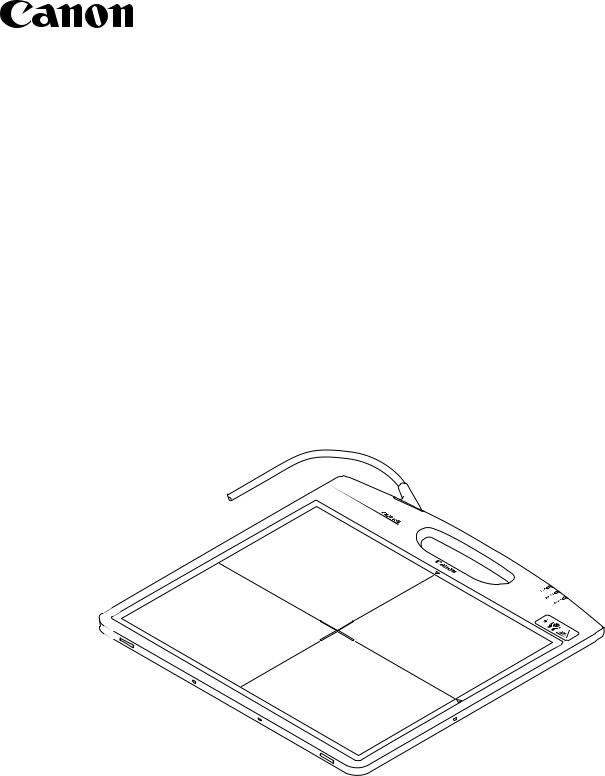
Digital Radiography
CXDI-55G
User’s Manual
Before using the instrument, be sure to read this manual thoroughly. Also, read the manuals of other instruments in the system.
Keep the manual where it is easily accessible.
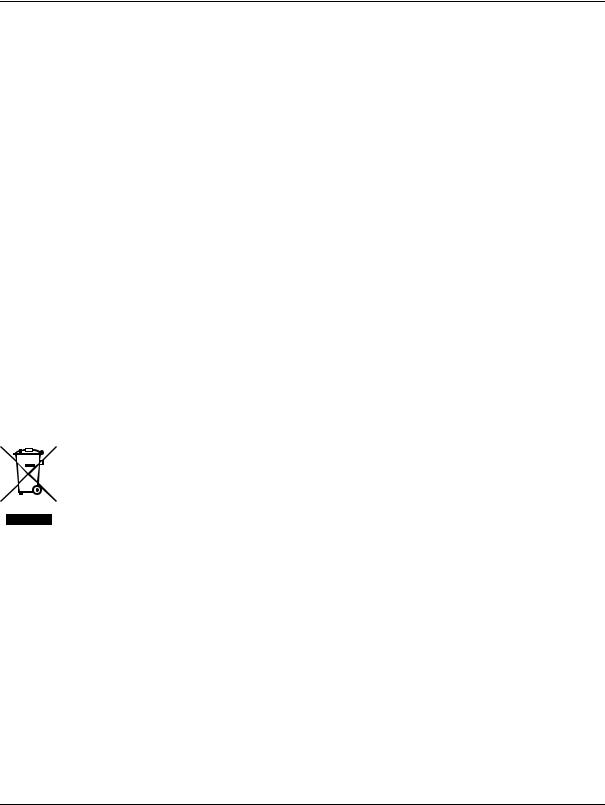
PLEASE NOTE
1.The user is responsible for the use and maintenance of the product.
We suggest that a member of the user’s staff be designated as being in charge of maintenance so as to ensure that the product is kept in a safe and good condition.
Also, medical products must be used only by a qualified person.
2.Roentgenography, image processing, reading of image, and storage of data must be performed in accordance with the law of the country where the product is being used.
Also, the user is responsible for maintaining the privacy of image data.
3.In no event will Canon be liable for direct or indirect consequential damage arising out of the use of this product. Canon will not be liable for loss of image data due to any reason.
4.This product may malfunction due to electromagnetic waves caused by portable personal telephones, transceivers, radio-controlled toys, etc. Be sure to avoid having objects such as these, which affect this product, brought near the product.
5.Disposal of this product in an unlawful manner may have a negative impact on health and on the environment. When disposing of this product, therefore, be absolutely sure to follow the procedure which is in conformity with the laws and regulations applicable in your area.
6.Canon reserves the right to change the specifications, configuration and appearance of the product without prior notice.
European Union (and EEA*) only.
This symbol indicates that this product is not to be disposed of with your household waste, according to the WEEE Directive (2002/96/EC) and your national law. This product should be handed over to a designated collection point, e.g., on an authorized one-for-one basis when you buy a new similar product or to an authorized collection site for recycling waste electrical and electronic equipment (EEE). Improper handling of this type of waste could have a possible negative impact on the environment and human health due to potentially hazardous substances that are generally associated with EEE. At the same time, your cooperation in the correct disposal of this product will contribute to the effective usage of natural resources. For more information about where you can drop off your waste equipment for recycling, please contact your local city office, waste authority, approved WEEE scheme or your household waste disposal service.
For more information regarding return and recycling of WEEE products, please visit www.canon-europe.com.
*EEA : Norway, Iceland and Liechtenstein
•System and product names in this manual are the trademarks of each manufacturer that developed them.
© CANON INC. 2009
All rights reserved.
Under copyright laws, this manual may not be copied, in whole or in part, without the written consent of Canon.
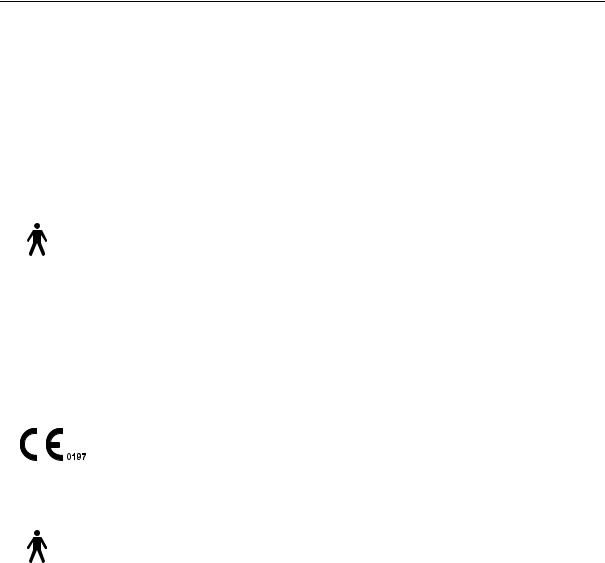
Safety Information
Regulations
This instrument conforms to IEC 60601-1-2:2001.
For U.S.A. and Canada
•This instrument is a CLASS I EQUIPMENT according to UL60601-1 and CAN/CSA C22.2 No.601.1.
•The following mark indicates that the instrument is a Type B Applied Parts.
•The degree of protection against ingress of water is IPX0.
•This equipment is not suitable for use in the presence of a flammable anaesthetic mixture with air or with oxygen or nitrous oxide.
•The mode of operation is Continuous Operation.
For EU Countries
•The following mark shows compliance of the instrument with Directive 93/42/EEC.
•This instrument has been classified into EN55011 Group 1/Class A.
•This instrument is a CLASS I EQUIPMENT according to EN 60601-1.
•The following mark indicates that the instrument is a Type B Applied Parts.
•The degree of protection against ingress of water is IPX0.
•This equipment is not suitable for use in the presence of a flammable anaesthetic mixture with air or with oxygen or nitrous oxide.
•The mode of operation is Continuous Operation.
(1)

Safety Information
Guidance and Manufacturer’s Declaration for EMC Directive
Electromagnetic Emissions
The CXDI-55G is intended for use in the electromagnetic environment specified below. The user of the CXDI-55G should assure that it is used in such an environment.
Emission Test |
Compliance |
Electromagnetic Environment – Guidance |
|
|
|
|
|
|
|
|
|
RF emissions |
GROUP 1 |
The CXDI-55G uses RF energy only for its internal func- |
|
CISPR 11 |
|
tion. Therefore, its RF emissions are very low and are not |
|
|
|
likely to cause any interference in nearby electromagnetic |
|
|
|
equipment. |
|
|
|
|
|
RF emissions |
Class A |
The CXDI-55G is suitable for use in all establishments |
|
CISPR 11 |
|
other than domestic and those directly connected to the |
|
|
|
public low-voltage power supply network that supplies |
|
Harmonic emissions |
Complies |
||
buildings used for domestic purposes. |
|||
IEC 61000-3-2 |
|
||
|
|
||
|
|
|
|
Voltage fluctuations/ |
Complies |
|
|
flicker emissions |
|
|
|
IEC 61000-3-3 |
|
|
|
|
|
|
(2)

Safety Information
Electromagnetic Immunity
The CXDI-55G is intended for use in the electromagnetic environment specified below. The user of the CXDI-55G should assure that it is used in such an environment.
Immunity Test |
IEC 60601 |
Compliance |
Electromagnetic Environment – Guidance |
|
Test Level |
Level |
|||
|
|
|||
|
|
|
|
|
|
|
|
|
|
Electrostatic dis- |
±(2, 4, 6) kV |
±(2, 4, 6) kV |
Floors should be wood, concrete or |
|
charge (ESD) |
contact |
contact |
ceramic tile. If floors are covered with syn- |
|
IEC 61000-4-2 |
|
|
thetic material, the relative humidity |
|
|
±(2, 4, 8) kV |
±(2, 4, 8) kV |
should be at least 30%. |
|
|
air |
air |
|
|
|
|
|
|
|
Electrical fast tran- |
±2 kV for |
±2 kV for |
Mains power quality should be that of a |
|
sient/burst |
power supply |
power supply |
typical commercial or hospital environ- |
|
IEC 61000-4-4 |
lines |
lines |
ment. |
|
|
±1 kV for |
±1 kV for |
|
|
|
input/output |
input/output |
|
|
|
lines |
lines |
|
|
|
|
|
|
|
Surge |
±1 kV differ- |
±1 kV differ- |
Mains power quality should be that of a |
|
IEC 61000-4-5 |
ential mode |
ential mode |
typical commercial or hospital environ- |
|
|
±2 kV com- |
±2 kV com- |
ment. |
|
|
|
|||
|
mon mode |
mon mode |
|
|
|
|
|
|
|
Voltage dips, short |
<5% UT |
<5% UT |
Mains power quality should be that of a |
|
interruptions and volt- |
(>95% dip in |
(>95% dip in |
typical commercial or hospital environ- |
|
age variations on |
UT) for 0.5 |
UT) for 0.5 |
ment. If the user of the CXDI-55G requires |
|
power supply input |
cycle. |
cycle. |
continued operation during power mains |
|
lines |
interruptions, it is recommended that the |
|||
|
|
|||
IEC 61000-4-11 |
40% UT |
40% UT |
CXDI-55G be powered from an uninter- |
|
|
ruptible power supply or a battery. |
|||
|
(60% dip in |
(60% dip in |
||
|
|
|||
|
UT) for 5 |
UT) for 5 |
|
|
|
cycles |
cycles |
|
|
|
70% UT |
70% UT |
|
|
|
(30% dip in |
(30% dip in |
|
|
|
UT) for 25 |
UT) for 25 |
|
|
|
cycles |
cycles |
|
|
|
<5% UT |
<5% UT |
|
|
|
(>95% dip in |
(>95% dip in |
|
|
|
UT) for 5 sec. |
UT) for 5 sec. |
|
|
Power frequency |
3 A/m |
3 A/m |
Power frequency magnetic fields should |
|
(50/60Hz) magnetic |
|
|
be at levels characteristic of a typical loca- |
|
field |
|
|
tion in a typical commercial or hospital |
|
IEC 61000-4-8 |
|
|
environment. |
|
|
|
|
|
NOTE: UT is the a.c. mains voltage prior to application of the test level.
(3)
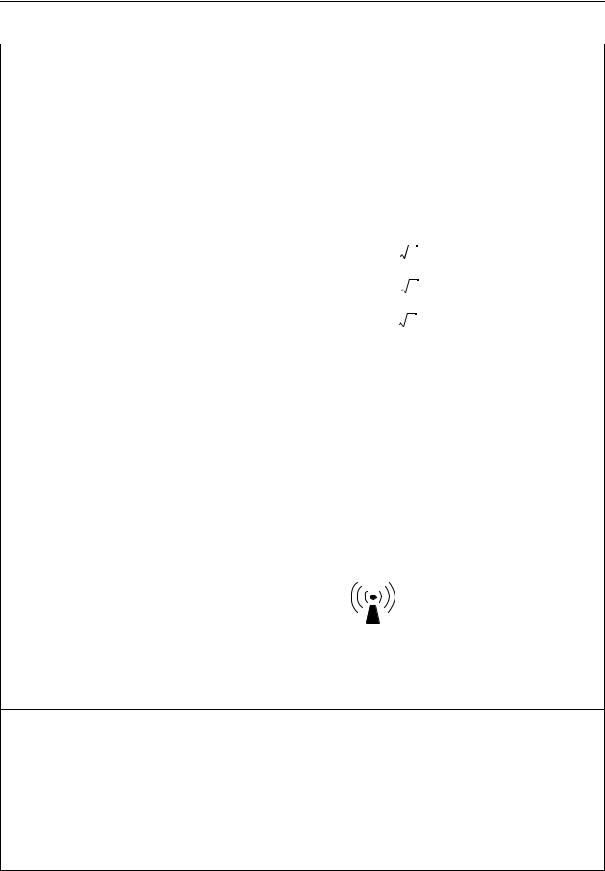
Safety Information
Immunity Test |
IEC 60601 Test |
Compliance |
Electromagnetic Environment – Guidance |
||
Level |
Level |
||||
|
|
|
|||
|
|
|
|
||
|
|
|
|
||
Conducted RF |
3 Vrms |
3Vrms |
Portable and mobile RF communications |
||
IEC 61000-4-6 |
150 kHz to 80 |
|
equipment should be used no closer to |
||
|
MHz |
|
any part of the CXDI-55G, including |
||
|
|
|
cables, than the recommended separation |
||
|
|
|
distance calculated from the equation |
||
Radiated RF |
3 V/m |
3 V/m |
applicable to the frequency of the trans- |
||
IEC 61000-4-3 |
80 MHz to 2.5 |
|
mitter. |
|
|
|
GHz |
|
Recommended separations distance |
||
|
|
|
|||
|
|
|
d = 1.2 |
P |
|
|
|
|
d = 1.2 |
P 80 MHz to 800 MHz |
|
|
|
|
d = 2.3 |
P 800MHz to 2.5 GHz |
|
|
|
|
where P is the maximum output power rat- |
||
|
|
|
ing of the transmitter in watts (W) accord- |
||
|
|
|
ing to the transmitter manufacturer and d |
||
|
|
|
is the recommended separation distance |
||
|
|
|
in metres (m). |
||
|
|
|
Field strengths from fixed RF transmitters, |
||
|
|
|
as determined by an electromagnetic site |
||
|
|
|
surveya, should be less than the compli- |
||
|
|
|
ance level in each frequency rangeb. |
||
|
|
|
Interference may occur in the vicinity of |
||
|
|
|
equipment marked with the following sym- |
||
|
|
|
bol: |
|
|
|
|
|
|
|
|
NOTE 1: At 80 MHz and 800 MHz, the higher frequency range applies.
NOTE 2: These guidelines may not apply in all situations. Electromagnetic propagation is affected by absorption and reflections from structures, object and people.
aField strengths from fixed transmitters, such as base stations for radio (cellular/cordless) telephones and land mobile radios, amateur radio, AM and FM radio broadcast and TV broadcast cannot be predicted theoretically with accuracy. To assess the electromagnetic environment due to fixed RF transmitters, an electromagnetic site survey should be considered. If the measured field strength in the location in which the CXDI-55G is used exceeds the applicable RF compliance level above, the CXDI-55G should be observed to verify normal operation. If abnormal performance is observed, additional measures may be necessary, such as reorienting or relocating the CXDI-55G.
bOver the frequency range 150 kHz to 80 MHz, field strengths should be less than 3 V/m.
(4)

Safety Information
Recommended Separation Distances
The CXDI-55G is intended for use in an electromagnetic environment in which radiated RF disturbances are controlled. The user of the CXDI-55G can help prevent electromagnetic interference by maintaining a minimum distance between portable and mobile RF communications equipment (transmitters) and the CXDI-55G as recommended below, according to the maximum output power of the communications equipment.
Rated maximum |
Separation distance according to frequency of transmitter |
|||
output power of |
|
m |
|
|
transmitter |
|
|
|
|
150 kHz ~ 80 MHz |
80 MHz ~ 800 MHz |
800 MHz ~ 2.5 GHz |
||
|
||||
W |
d = 1.2 P |
d = 1.2 P |
d = 2.3 P |
|
|
|
|
|
|
|
|
|
|
|
0.01 |
0.12 |
0.12 |
0.23 |
|
|
|
|
|
|
0.1 |
0.38 |
0.38 |
0.73 |
|
|
|
|
|
|
1 |
1.2 |
1.2 |
2.3 |
|
|
|
|
|
|
10 |
3.8 |
3.8 |
7.3 |
|
|
|
|
|
|
100 |
12 |
12 |
23 |
|
|
|
|
|
|
For transmitters rated at a maximum output power not listed above, the recommended separation distance d in metres (m) can be estimated using the equation applicable to the frequency of the transmitter, where P is the maximum output power rating of the transmitter in watts (W) according to the transmitter manufacturer.
NOTE 1: At 80 MHz and 800 MHz, the separation distance for the higher frequency range applies.
NOTE 2: These guidelines may not apply in all situations. Electromagnetic propagation is affected by absorption and reflection from structures, objects and people.
NOTE 1: To maintain the optimum EMC performance, use only the cables which are designated.
Name |
Type of shield |
Length |
Notes |
|
|
|
|
|
|
|
|
Power cable |
Non-shielded |
3 m |
Provided with Power Box |
|
|
|
|
Sensor cable |
Shielded |
7.8 m |
Provided with the Sensor Unit |
|
|
|
|
X-ray interface cable |
Non-shielded |
20 m |
Provided with Power Box |
|
|
|
|
Remote switch cable |
Non-shielded |
20 m |
Provided with Power Box |
|
|
|
|
LAN cable |
Non-shielded |
Max. 20 m |
Not provided |
|
|
|
|
NOTE 2: Do not install the CXDI-55G and Power Box (CXDI SYSTEM II) adjacent to or stacked on top of or underneath any other system devices.
NOTE 3: Essential Performance in terms of Electromagnetic Disturbances
•No adverse effects on image acquisition
•No adverse effects on image data transmission
(5)

Safety Information
General Safety Information
Follow the safety instructions in this manual and all warnings and cautions printed on the warning labels. Ignoring such cautions or warnings while handling the product may result in injury or accident. Be sure to read and fully understand the manual before use.
Keep this manual for future reference.
|
|
Meaning of Caution Signs |
|
|
|
! |
WARNING |
This indicates a potentially hazardous situation which, if not heeded, could |
result in death or serious injury to you or others. |
||
|
|
|
! |
CAUTION |
This indicates hazardous situation which, if not heeded, may result in minor or |
moderate injury to you or others, or may result in machine damage. |
||
|
|
|
|
NOTE |
This is used to emphasize essential information. |
|
Be sure to read this information to avoid incorrect operation. |
|
|
|
|
|
|
|
Installation and Environment of Use
|
|
Do not use or store the instrument near any flammable chemicals such as |
|
|
alcohol, thinner, benzine, etc. Also, this instrument is not a category AP or |
! |
WARNING |
APG equipment. If chemicals are spilled or evaporate, it may result in fire or |
electric shock through contact with electric parts inside the instruments. Also, |
||
|
|
some disinfectants are flammable. |
|
|
Be sure to take care when using them. |
|
|
|
|
|
Do not install the instrument in a location with the conditions listed below. |
|
|
Otherwise, it may result in failure or malfunction, fall or cause fire or injury. |
|
|
• Close to facilities where water is used. |
|
|
• Where it will be exposed to direct sunlight. |
|
|
• Close to air-conditioner or ventilation equipment. |
! |
CAUTION |
• Close to heat source such as a heater. |
• Prone to vibration. |
||
|
|
• Insecure place. |
|
|
• Dusty environment. |
|
|
• Saline or sulfurous environment. |
|
|
• High temperature or humidity. |
|
|
• Freezing or condensation. |
|
|
|
Installation Operation
! WARNING |
Do not connect the instrument with anything other than specified. |
Otherwise, it may result in fire or electric shock. |
|
|
|
(6)

Safety Information
Power Supply
|
|
Be sure to turn OFF the power of each instrument before connecting or dis- |
! |
WARNING |
connecting the cables. |
Also, do not handle them with wet hands. Otherwise, you may get an electric |
||
|
|
shock that may result in death or serious injury. |
|
|
|
|
|
Be sure to hold the plug or connector to disconnect the cable. |
! |
WARNING |
If you pull the cable, the core wire may be damaged, resulting in fire or electric |
|
|
shock. |
|
|
|
|
|
Do not cut or process the cables. Also, do not place anything heavy, including |
! |
WARNING |
the instrument on it, step on it, pull it, bend it, or bundle it. |
Otherwise, the cable may be damaged, which may result in fire or electric |
||
|
|
shock. |
|
|
|
! |
WARNING |
Do not turn ON the system power when condensation is formed on the instru- |
ment. Otherwise, it may result in fire or electric shock. |
||
|
|
|
! |
CAUTION |
Because the instrument’s cable is long, take care so cables do not get tangled |
during use. Also, be careful not to get your feet caught in the cable. |
||
|
|
|
Handling |
|
|
|
|
|
|
|
Always be sure to keep checking the condition of the system and the patient |
! |
WARNING |
to ensure they are normal during the use of the instrument. |
If any problem is found, take appropriate measures, such as stopping the |
||
|
|
operation of the instrument, as required. |
|
|
|
|
|
Never disassemble or modify the product as it may result in fire or electric |
! |
WARNING |
shock. Also, since the instrument incorporates parts that may cause electric |
shocks and other hazardous parts, touching them may cause death or serious |
||
|
|
injury. |
|
|
|
|
|
Do not hit or drop the instrument. The instrument may be damaged if it |
! |
WARNING |
receives a strong jolt, which may result in fire or electric shock if the instru- |
|
|
ment is used without it being repaired. |
|
|
|
|
|
Do not spill liquid or chemicals onto the instrument or, in cases where the |
! |
CAUTION |
patient is injured, allow it to become wet with blood or other body fluids, as |
doing so may result in fire or electric shock. In such situation, protect the |
||
|
|
instrument with disposable covering as necessary. |
|
|
|
|
|
Wipe the CFRP plate of the sensor unit with ethanol or glutaraldehyde solu- |
|
|
tion to disinfect it each time a different patient uses the instrument, in order to |
! |
CAUTION |
prevent infection. |
|
|
If the optional grid unit is being used, disinfect its surface. |
|
|
Please consult a specialist for the procedure for disinfection. |
|
|
|
! |
CAUTION |
Turn off the power of each instrument for safety when they are not going to be |
used. |
||
|
|
|
(7)
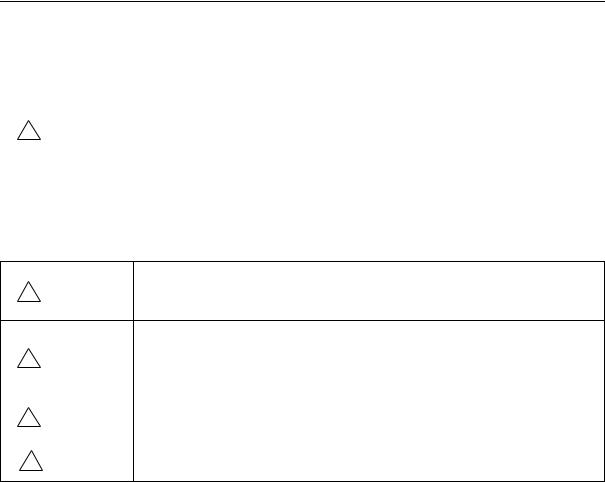
Safety Information
When Problem Occurs
|
|
Should any of the following occur, immediately turn OFF the power of each |
|
|
instrument, unplug the power cable from the AC outlet, and contact Canon |
|
|
representative or distributor. |
! |
WARNING |
• When there is smoke, odd smell or abnormal sound. |
|
|
• When liquid has been spilled into the instrument or a metal object has |
|
|
entered through an opening. |
|
|
• When the instrument has been dropped and it is damaged. |
|
|
|
Maintenance and Inspection
For safety reasons, be sure to turn OFF the power of each instrument when
! WARNING the inspections indicated in this manual are going to be performed. Otherwise, it may result in electric shock.
|
|
When the instrument is going to be cleaned, be sure to turn OFF the power of |
! |
WARNING |
each instrument, and unplug the power cable from the AC outlet. |
Never use alcohol, benzine, thinner or any other flammable cleaning agents. |
||
|
|
Otherwise, fire or electric shock may result. |
|
|
|
! |
WARNING |
The instrument must be repaired by a qualified engineer only. |
If it is not repaired properly, it may cause fire, electric shock, or accident. |
||
|
|
|
! |
CAUTION |
For safety reasons, be sure to inspect the instrument before using it. |
In addition, carry out a regular inspection at least once a year. |
(8)
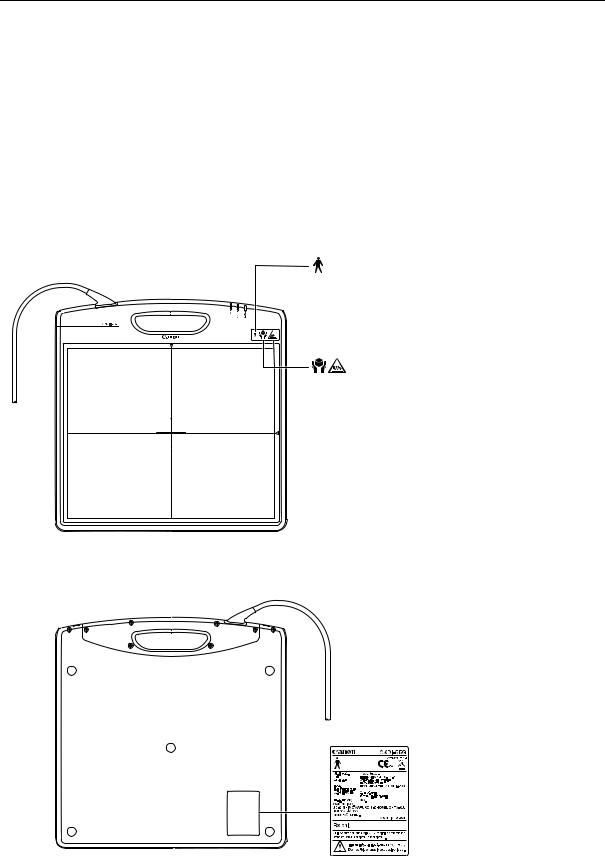
Safety Information
Labels and Markings on the Instrument
The CXDI-55G has a few labels and markings on it.
Contents of those and positions where they are attached are indicated below.
Sensor Unit
Front
This mark indicates that this is a Type B Applied Part according to UL60601-1 and EN60601-1.
This unit can be installed in the patient environment.
These marks indicate that the instrument must be handled with care.
Do not jolt or apply excessive load to the instrument.
Rear
Name Label
(9)
